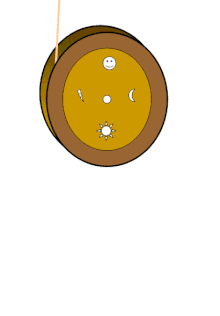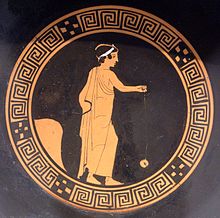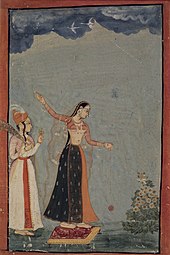
A ball bearing is a type of rolling-element bearing that uses balls to maintain the separation between the bearing races.

A bearing is a machine element that constrains relative motion to only the desired motion and reduces friction between moving parts. The design of the bearing may, for example, provide for free linear movement of the moving part or for free rotation around a fixed axis; or, it may prevent a motion by controlling the vectors of normal forces that bear on the moving parts. Most bearings facilitate the desired motion by minimizing friction. Bearings are classified broadly according to the type of operation, the motions allowed, or the directions of the loads (forces) applied to the parts.

The diabolo is a juggling or circus prop consisting of an axle and two cups or discs derived from the Chinese yo-yo. This object is spun using a string attached to two hand sticks. A large variety of tricks is possible with the diabolo, including tosses, and various types of interaction with the sticks, string, and various parts of the user's body. Multiple diabolos can be spun on a single string.

A spinning top, or simply a top, is a toy with a squat body and a sharp point at the bottom, designed to be spun on its vertical axis, balancing on the tip due to the gyroscopic effect.

Bolas or bolases is a type of throwing weapon made of weights on the ends of interconnected cords, used to capture animals by entangling their legs. Bolas were most famously used by the gauchos, but have been found in excavations of Pre-Columbian settlements, especially in Patagonia, where indigenous peoples used them to catch 200-pound guanacos and rheas. The Mapuche and the Inca army used them in battle. Mapuche warriors used bolas in their confrontations with the Chilean Army during the Occupation of Araucanía (1861–1883).

A whirligig is an object that spins or whirls, or has at least one part that spins or whirls. It can also be a pinwheel, spinning top, buzzer, comic weathervane, gee-haw, spinner, whirlygig, whirlijig, whirlyjig, whirlybird, or simply a whirly. They are most commonly powered by the wind but can be hand-, friction- or motor-powered. They can be used as kinetic garden ornaments, and can be designed to transmit sound and vibration into the ground to repel burrowing rodents.

Astrojax, invented in 1986 by Larry Shaw, is a toy consisting of three balls on a string. In the original version of the toy, one ball is fixed at each end of the string, and the center ball is free to slide along the string between the two end balls. Inside each ball is a metal weight. The metal weight lowers the moment of inertia of the center ball so it can rotate rapidly in response to torques applied by the string. This prevents the string from snagging or tangling around the center ball.
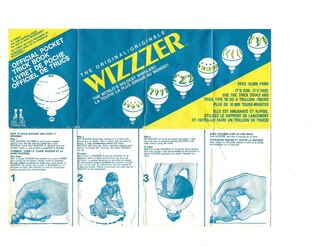
The Wizzzer or Wiz-z-zer is a gyrostat toy introduced by Mattel Toymakers in 1969, and introduced the spinning top to modern children. The "twist" (innovation) was the use of a super-spinning, high-tech bearing, that allowed the top to spin at very high speed and remain standing for a long period of time. This top did not rely on a string to attain high speed so it was easier to master than tops of old. Wizzers are not sold as scientific instruments, but may be used to demonstrate the conservation of angular momentum and gyroscope stability.

Tapered roller bearings are rolling element bearings that can support axial forces as well as radial forces.

A trompo is a top which is spun by winding a length of string around the body, and launching it so that lands spinning on its point. If the string is attached to a stick the rotation can be maintained by whipping the side of the body. The string may also be wound around the point while the trompo is spinning in order to control its position or even lift the spinning top to another surface.
Steve Brown is an American competitive yo-yo player, competition judge, yo-yo designer, and yoyo blogger currently based out of North Olmsted, Ohio. He is currently the editor for YoYoNews.com and a co-producer of the Triple Crown of YoYo events. In 2001, the National Yo-Yo League named him as one of eight National Yo-Yo masters. He has designed multiple yo-yos, including the "Cherry Bomb" for Team Losi. While employed by Duncan Toys Company as marketing and promotions coordinator, Brown invented and patented freehand yo-yo play where instead of being attached to the finger, the string is actually attached to a counterweight, and designed a line of yo-yos for the new style. He also authored a book called Duncan Yo-Yo Trick Book while employed by the company.
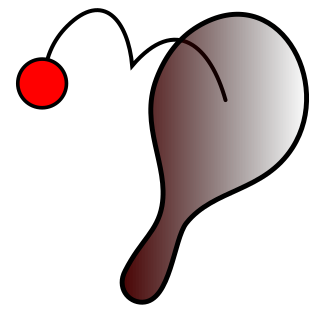
Paddle ball is a one-person game played with a paddle and an attached ball. Using the flat paddle with the small rubber ball attached at the center via an elastic string, the player tries to hit the ball with the paddle in succession as many times as possible.

The Duncan Toys Company is an American toy manufacturer based in Middlefield, Ohio. The company was founded in 1929 by Donald F. Duncan Sr. and purchased the Flores Yo-Yo Company from Pedro Flores, who brought the yo-yo to the United States from the Philippines.Duncan popularized the yo-yo through competitions that spread throughout the country, promoted in publications by William Randolph Hearst in exchange for a requirement that contestants had to sell subscriptions to Hearst newspapers as a condition of entry. In 1965, a federal court ruled that Duncan did not have exclusive rights to the word "yo-yo" because the word had become a part of common speech. In 1968, Duncan Toys became a division of Flambeau.
Pedro Edralin Flores was a Filipino businessman and yo-yo maker who has been credited with popularizing yo-yos in the United States. He patented an innovation to yo-yos that used a loop instead of a knot around the axle, allowing for new tricks such as the ability to "sleep."

Blazing Teens is a Chinese television series created by Alpha Group Co., Ltd. and Auldey Toys in 2006. It is the television adaptation of Auldey's yo-yo line of the same name.
Asia Pacific Yo-Yo Championships (AP) is Asia's most renowned and premier yo-yo competition organized by Spinworkx, a company based in Singapore since 2003. The competition has grown steadily since its inception in 2003. Spinners from around the region get to compete with current world champions, trade tips and tricks with the best in the scene, raising the standard of spinning.
International Yo-Yo Federation (IYYF) is an international Yo-yo organization that promotes World Yo-Yo Contest and European Yo-Yo Championship and develops and promotes yo-yoing as a sport on a global level.

An Eskimo yo-yo or Alaska yo-yo is a traditional two-balled skill toy played and performed by the Eskimo-speaking Alaska Natives, such as Inupiat, Siberian Yupik, and Yup'ik. It resembles fur-covered bolas and yo-yo. It is regarded as one of the most simple, yet most complex, cultural artifacts/toys in the world. The Eskimo yo-yo involves simultaneously swinging two sealskin balls suspended on caribou sinew strings in opposite directions with one hand. It is popular with Alaskans and tourists alike. This traditional toy is two unequal lengths of twine, joined together, with hand-made leather objects at the ends of the twine.

String is a long flexible structure made from fibers twisted together into a single strand, or from multiple such strands which are in turn twisted together. String is used to tie, bind, or hang other objects. It is also used as a material to make things, such as textiles, and in arts and crafts. String is a simple tool, and its use by humans is known to have been developed tens of thousands of years ago. In Mesoamerica, for example, string was invented some 20,000 to 30,000 years ago, and was made by twisting plant fibers together. String may also be a component in other tools, and in devices as diverse as weapons, musical instruments, and toys.

